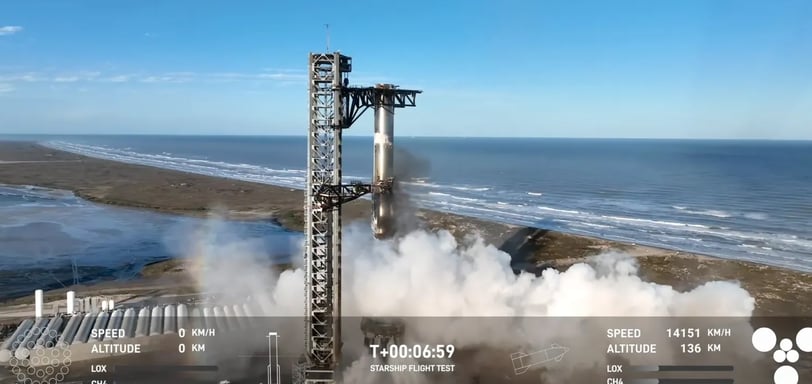SpaceX Successfully Lands Starship Booster Twice but Loses Ship to Some ‘Anomaly’ | Tracer Tecz
SpaceX once again landed the Starship’s booster back on a floating platform while they lost yet another ship to an ‘anomaly’ recently.
1/17/20253 min read


The Starship rocket’s Super Heavy booster was caught for a second time, following the launch of the upper stage into space on Thursday during SpaceX’s seventh test flight of the system. After a successful catch of the deployed awesome Thud, SpaceX representatives stated that the ship was lost after they could not communicate with them about eight and half minutes into the flight. The ship had successfully ejected from the booster and had ignited its own rocket engines to reach orbit before it looked like some of those engines failed.
The company then lost the connection to the telemetry coming off of the ship and several minutes later SpaceX said that the ship had an “anomaly with that upper state during the end of its ascent burn in space”. That said, the Federal Aviation Administration stated to TechCrunch that it changed or delayed a number of flights in the area where the debris was found. It was 24 minutes into the live stream, on Thursday evening, when, Musk tweeted on X, that SpaceX believes there was an “oxygen/fuel leak,” which caused pressure to build up inside the cavity of Starship. He added that SpaceX will “obviously [be] double-checking for leaks” proceeding this, integrate a fire suppression system into that part of the ship, as well as increasing the area of the vent to try and lessen any pressure.
But after the ship failed, users of the social media site Twitter as well as Instagram posted pictures and videos that showed debris believed to be from the spacecraft shortly before it plunged into the Earth’s atmosphere and burnt up over Turks and Caicos. In between posts where he complained about corporate diversity initiatives, Musk shared one of the videos on X, writing: The state of success is very unpredictable while the factor of entertainment is specially assured here.
The first booster “catch” where articulated arms on the launch tower grab the rocket stage out of the air as it uses rockets to slow it down happened in October 2024. That effort to catch the booster in November was also aborted due to a lack of communication. Of course, this launch was about much more than another catch, though. During SN8’s prototype launch, SpaceX had filled Starship with 10 proto-type Starlink satellites and had intended on performing the first payload ejection with the spacecraft. The test was supposed to be the beginning of a “transformational year” for Starship, according to SpaceX on its page.
The spacecraft SpaceX launched on Thursday was modified from previous test flights in multiple ways. On its part, SpaceX revealed this Starship flight computer for its avionics systems was redesigned and integrated with antennas for Starlink, GNSS, and an RF backup comms. The move increased the ship’s inertial navigation and star tracking sensors, connected ‘smart batteries and power units’ that SpaceX said provided data and up to 2.7MW to the vessel.
This latest version of Starship also had over 30 cameras on board so the company’s engineers can see the performance of all this newly added as well as existing technology. SpaceX is slowly developing the technology it needs to attempt to catch Starship along with the booster in future, this flight was set to test some of these technologies. The company installed numbers of distinct heat tiles on the ship with an aim of finding out which type of tiles gives the best protection in the forces of re-entry. The ship also had “non-structural versions” of the knobs that get caught by the tower, in order to see how they would fare during re-entry.
On the booster side of things, SpaceX had installed radar sensors for the instantaneous location of the rocket stage during the catch phase. The booster was also re-using one of the rocket engines from a previous Starship flight for the first time.
Credit: Space 'X'
Insights
Stay updated on technology and AI advancements.
info@tracertacz.com
© 2024. All rights reserved.
